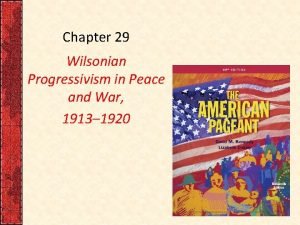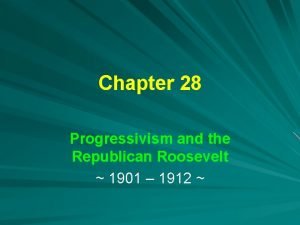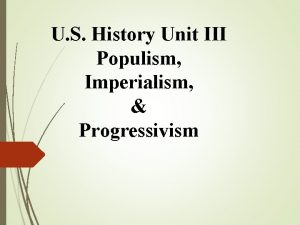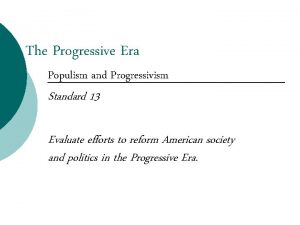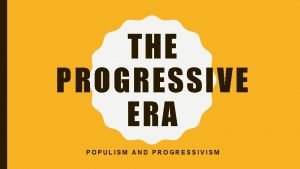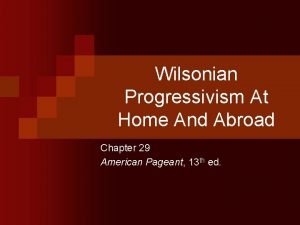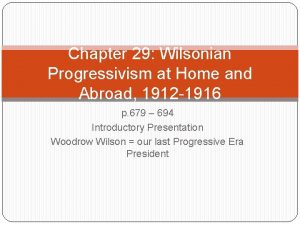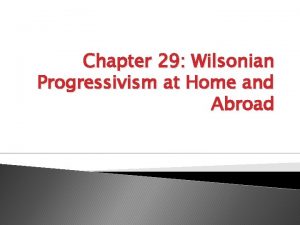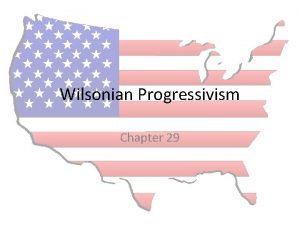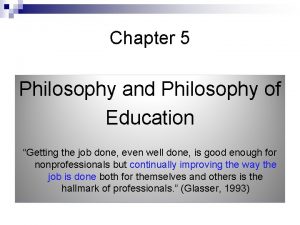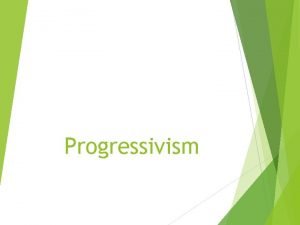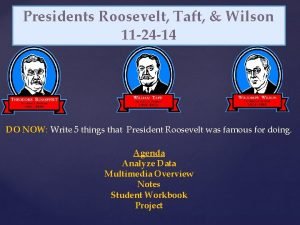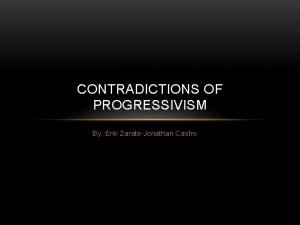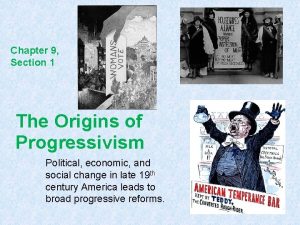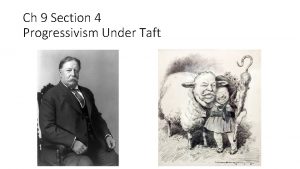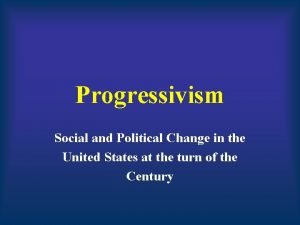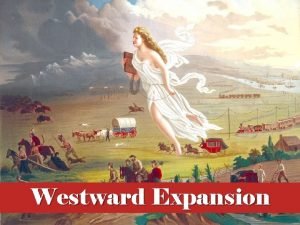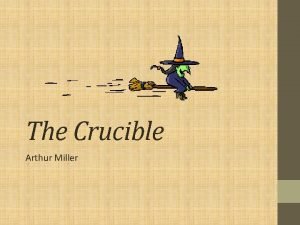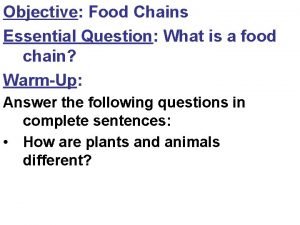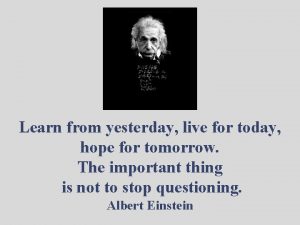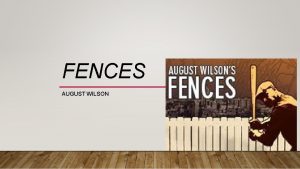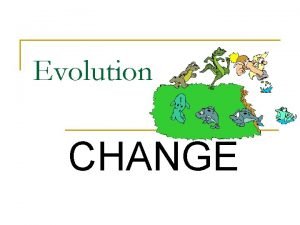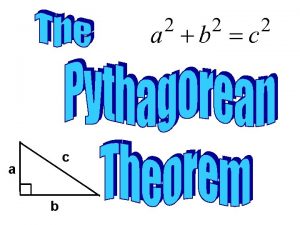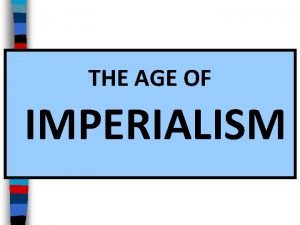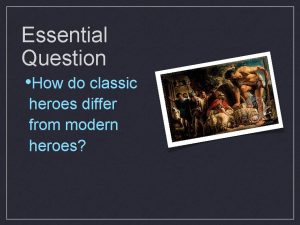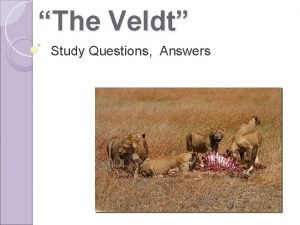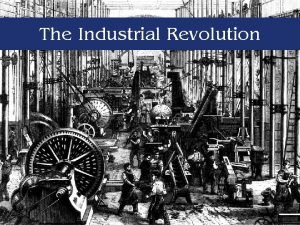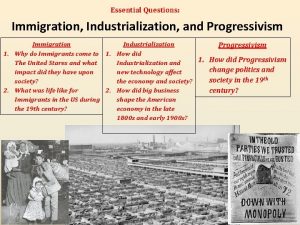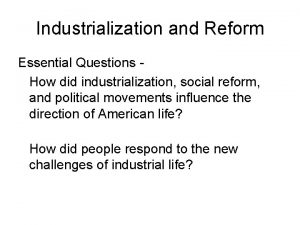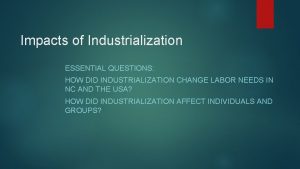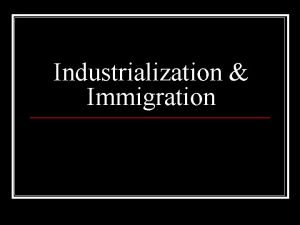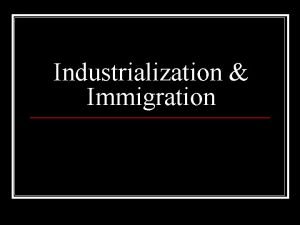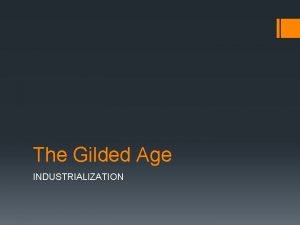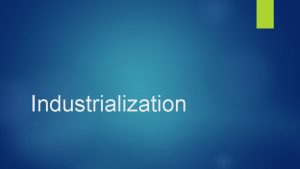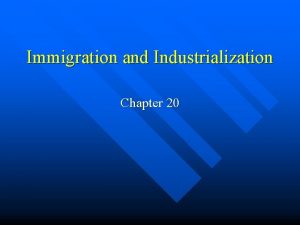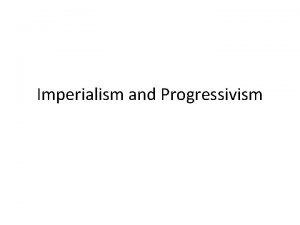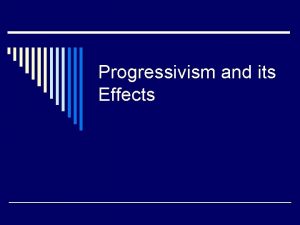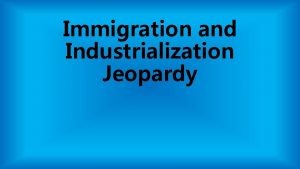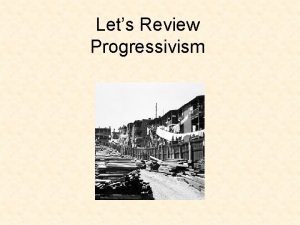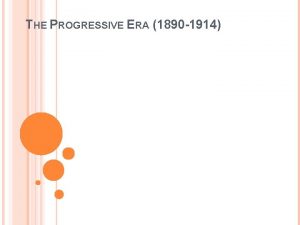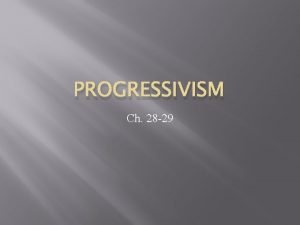Essential Questions Immigration Industrialization and Progressivism Immigration Industrialization


































































- Slides: 66

Essential Questions: Immigration, Industrialization, and Progressivism Immigration Industrialization Progressivism 1. Why do Immigrants come to 1. How did Progressivism The United States and what Industrialization and change politics and impact did they have upon new technology affect society in the 19 th society? the economy and society? 2. What was life like for 2. How did big business century? Immigrants in the US during shape the American the 19 th century? economy in the late 1800 s and early 1900 s?

Immigration 1840 - 1914 Essential Questions: • Why do Immigrants come to The United Stares and what impact did they have upon society? • What was life like for Immigrants in the US during the 19 th century?

Immigration Quick Questions: What percent of United States citizens are immigrants or descended from immigrants? - 99. 9% What is the longest unfortified border in the world? - Canada and the United States What ethnic group do Americans claim more than any other as their primary ancestry on the US Census? - German… with Irish a close second

Immigration to the United States • Three Phases of Immigration to the United States – First Wave – Colonial Period 1600 s – 1700 s • English/ Scots Irish Immigrants – Family immigration first in New England (largest population growth during colonial period) – Second Wave – 1840 s – 1920 s • 1840 s – 1870 s = Irish & German Immigrants (Northern European) – Irish = Potato Famine and ‘the Troubles’ continue to create push factors • 1870 s – 1920 s = Italian & Polish immigrants (Southern and Eastern European) – Often chain migration (one family member makes enough $ to send of other family members) or Temporary Migration (return to home country after a few years) – depends on push factors – Third Wave – 1965 (Immigration Leg. ) – Present • Current Immigration primarily from Asian, Latin America (Mexico) • Often Circle Migration

I. New Immigrants come to America When? Who? A. Two ‘Phases’ of Immigration 1. Irish/ German 2. Southern/Western Europeans (often Polish & Italian) B. Often unskilled, poor, Catholic or Jewish (big generalization… but remember the push factors) C. Majority Settled in Cities & contributed further to Urbanization

II. Why do Immigrants decide to leave home? Push and Pull Factors Push Factors

II. Why do Immigrants decide to leave home? Push and Pull Factors Job opportunities Inexpensive land Family reunification better living conditions Political and/or religious freedom – Education – – – Push Factors – Lack of job opportunities – Low standard of living • Famine, poverty, and war – Lack of religious freedom – Lack of educational opportunities – Poor medical care – Natural disasters

Immigrant Explorer Activity Historical Migration Task: Analyze the Interactive Immigration Map to determine Who is coming to the US and Where they are settling.


Immigration to the United States • Three Phases of Immigration to the United States – First Wave – Colonial Period 1600 s – 1700 s • English/ Scots Irish Immigrants – Family immigration first in New England (largest population growth during colonial period) – Second Wave – 1840 s – 1920 s • 1840 s – 1870 s = Irish & German Immigrants (Northern European) – Irish = Potato Famine and ‘the Troubles’ continue to create push factors • 1870 s – 1920 s = Italian & Polish immigrants (Southern and Eastern European) – Often chain migration (one family member makes enough $ to send of other family members) or Temporary Migration (return to home country after a few years) – depends on push factors – Third Wave – 1965 (Immigration Leg. ) – Present • Current Immigration primarily from Asian, Latin America (Mexico) • Often Circle Migration

New vs. Old Immigrant Groups


Anti-Catholic Political Cartoon


Arriving in America • Interpreting Information • Describe the process immigrants went through on Ellis Island.

Immigration Centers Prior to 1890 Immigration Centers 1892– 1954 Canada – Goose Island Ellis Island - NYC Deer Island - Boston Immigration Centers 1965 – Present LAX Airport – Los Angeles Castle Garden - New York Southwest Immigration Detention Centers

Citizenship in The United States • Naturalization Act of 1790 – 1 st Law regulating the granting of national citizenship – Limited naturalization to ‘free white persons, ’ required 2 yrs of residence, your father had to be a citizen • 14 th Amendment (1868) – Granted citizenship to people born in the US regardless of race, or place of birth. (not extended to American born children of Chinese parents till 1898 – court case)

Immigration Regulation • Chinese Exclusion Act (1882 - 1943) – Stopped the immigration from Asia • Immigration Act of 1924 – Put quotas on how many immigrants were permitted based on country of origin (skewed towards Northern Europeans) • Immigration and Nationality Act of 1952 – Abolished racial restrictions but retained a quota system for nationalities and regions (preference system based on ethnic group and labor qualifications) • Immigration and Nationality Act of 1965 – Abolished the national-origin quotas system • Immigration Act of 1990 (signed by George Bush) – Increased legal immigration to the US by 40% – Increased enforcement of Immigration laws post 9/11

U. S. Immigration Policies · 1980, Refugee Act - quotas do not apply to those seeking political asylum · 1986, Immigration Reform and Control Act admitted large numbers of former illegals. · 1990, Immigration Act raised global quotas to roughly 675, 000 · 1995, visas issued Preferentially: – 480, 000 - to relatives of people here – 140, 000 - to those with special skills and education – 55, 000 - to diversity candidates (i. e. , mostly not from Latin Amer. or Asia) Current Total: 675, 000

• The US allows more than 1 million immigrants to become Legal Permanent Residents every year – Based on number of Permanent resident visas issued.

Immigrants Change America • Fuel Industrial Growth – Labor supply for factories • Encourage rapid urbanization (especially in Northeast & Midwest) • Made their traditions a part of American Culture – Multiple Theories on the impact of immigration on US Culture – Process known as Cultural Assimilation • How do Immigrants become American?

Theories on Immigrant Assimilation How Do Immigrants Become American? The ‘Melting Pot’ Model The ‘Salad Bowl’ Model Summarize: Strengths Weaknesses Strengths The ‘Multiple Consiousness’ Model Summarize: Weaknesses Strengths Weaknesses

Paragraph Structure • Topic Sentence (argument & reference your position) • Structure Example for using Supporting details in a sentence: – Tag quote, “piece of evidence that supports your statement. This can be a direct or indirect quote or a description of a visual source, but it must relate to the statement that you have made, ” (Abbreviated Citation). Explanation on the significance of the evidence and how it related back to your argument. • Conclusion

The Immigrant Experience Jigsaw Instructions • Warm up Task: Summarize the instructions for the jigsaw in your own words and have your main group representative bring me your summaries and any questions your group might have. • Each of you have been put into “main groups” for phase 1 of this activity with one individual assigned the task of group representative. You will also have a “Color group” for Phase 2 of this activity based on the color on your document sheets. • Your main group will be given a document to analyze. You will become the Expert on this document by answering the document questions and present this information to your color group. • Your color group will create an organizer that includes information on a number of diverse aspects of the immigrant experience during the 19 th century based on the 4 different document sources from each main group. • Once your color group has completed the organizer for the documents your color group representative will get 4 photos on living and working conditions for you to analyze as a group. • Your color group should then have a brief discussion on what supporting details you have found that could help you answer the question: Was 19 th century American a land of opportunity for immigrants? • Exit Slip: At the end of the lesson you will reflect on what you learned during the lesson and your impression of the lesson itself. • *the information that you collect today will be used to complete an argumentative essay. Your groups should focus on finding supporting detail that would be useful in an argumentative essay.

Was 19 th-century America a land of opportunity for immigrants?

Positive Experiences Negative Experiences Doc 1 – Letter’s Home Positive – Evidence of Economic Success 1. Doc 3 – Two views on the Nativist Perspective Negative - Evidence of Economic Failure 1. Positive – Evidence of Positive Experiences in American Society 1. 1. Negative – Evidence of Negative Experiences In American Society 1. 1. Doc 2 – Oral History of Frank Klosowski Positive – Evidence of Economic Success 1. Doc 4 – Two view on the impact of Immigration Negative - Evidence of Economic Failure 1. Negative – Evidence of Negative Experiences In American Society 1. Positive –Evidence of Positive Experiences in American Society 1.

Photographic Analysis of Living and Working Conditions Living Conditions Working Conditions Photo 1 – Italian Immigrant Family 1897 Photo 2 – Coal Miners in 1920 What observation can you make about working conditions in this What observations can you make about the living conditions in this photo? Photo 3 - Slumdwellers salute Photo 4/ 5 – Pictures of Immigrant Businesses What observations can you make about educational opportunities What economic opportunities did America offer to immigrants that and the purpose of education in the United States at this time? their home countries did not?

Industrialization The time period in which America changes socially and economy from an agrarian society into an industrial one. Industrial Model = production of a good broken down into separate tasks in a factory which, with the use of technology, creates Mass Production. Review from WH 2 What were the benefits and drawbacks of Industrialization in England? Benefits Drawbacks

• Fast Fact America the Story of US The Creation of Cities – The largest internal migration in US history was the rural to urban migration that occurred in the late 1870 s – 1920 s What elements were necessary for the creation of the Modern US city? 1. 2. • Immigration + Industrialization created a unique urban landscape 3. 4.

Industrialization Causes • The Civil War • Vast amount of natural resources • Entrepreneurs • Large number of immigrants • Protective Tariffs • Laissez-Faire Economics • New inventions • Expanding railroad systems Effects • Factories, railroads, and mines created new jobs and drew foreign investors • American made goods became cheaper than imported goods (dominate the world market) • Businesses operated with little gov’t regulation (low wages, dangerous conditions, Environmental damage, etc…) • Mass production of goods

The Rise of Large Corporations Rise of Corporations • Monopolies • Cartels • Horizontal Integration • Trusts • Vertical Integration Debates over Big Business • Small Businesses bought up or squeezed out by competition • Consumers paid high prices • Providing Jobs • Business leaders as philanthropists • • Andrew Carnegie: U. S. Steel (1870 s) John D. Rockefeller: Standard Oil (1880 s)

A company controls an entire industry or area of the economy Review from WH 2 Because of its size and power, the company can destroy any competition Lack of competition means company can charge what they want for the product

Monopolies Standard Oil, 1906

Standard Oil • http: //www. pbs. org/wgbh/amex/rockefellers/sfeature/sf_1. html

How is big business portrayed today? How are these cartoons similar or different from the late 1800 s cartoon?

Brainstorm Laissez-faire vs. Regulation • Should government become involved in business? Pros of Governmental involvement Cons of Government Involvement News: Septempber: 2011 - The U. S. Department of Justice filed an antitrust lawsuit against AT&T on Wednesday seeking to block its $39 billion merger with T-Mobile. The merger would create the largest wireless company in the United States, combining AT&T's 98 million customers with TMobile's 34 million users, for a total of 130 million subscribers. AT&T is currently the second-largest wireless company by number of subscribers, and T-Mobile is fourth. The DOJ said the merger would lead to a situation in which just two companies -- the AT&T-T-Mobile combination and Verizon Wireless -- would dominate the mobile market. The new AT&T and Verizon would account for more than two-thirds of wireless subscribers and 78% of the wireless industry's revenues.

Robber Barons or Captains of Industry • • Andrew Carnegie: U. S. Steel (1870 s) John D. Rockefeller: Standard Oil (1880 s)

Warm Up Activity: Creating Arguments = expressing a point of view on a subject and supporting it with evidence • Strong Arguments should include a both a statement and supporting evidence – Read UNC’s definition of a strong argument – Use the information from chapter 13, and the Story of US video & think of 2 pieces of supporting evidence for each of the arguments that you created. • Did Business leaders help or hinder the US economy during the American Industrial Revolution? http: //writingcenter. unc. edu/handouts/argument/

Gradual Government Regulation 1. Railroad industry controls economy 2. Midwestern states pass laws regulating freight rates 3. Supreme Court strikes down state laws 4. Senate creates the interstate Commerce Commission 5. Senate passes the Sherman Antitrust Act

Characterization of American Industrialization • Urbanization (Growth of Cities) – City offers work, education & entertainment opportunities – Slum Conditions = crowding, crime & sickness • Growth of Big Business – New Business tactics – Profits for the rich – low wages for the laborers • Large Scale Immigration • – Opportunities in America – Poor living & working conditions

Responses to Industrialization and Unrestrained Capitalism The Labor Movement Grows Workers Suffer - Long Hours - Sweatshops - Dangerous Conditions Strikes Break Out - Haymarket Riot - Homestead Strike Pullman Strike Labor Unions Organize - National Trade Union - Knights of Labor - AFL

The Organized Labor Movement Lowell Mill Girls 1836 American Federation of Labor 1886 Knights of Labor 1869 Industrial Workers of the World 1905 Principles (why was the group founded) underlying problems Goals (what they want to accomplish) Tactics (how they want to accomplish these goals)

Discuss as a group – was the labor movement successful? How was the labor movement NOT successful?

Major Strikes of the Late 1800 s Strike Causes Effect Railroad Strikes 1877 Response to cuts in workers’ wages Set the scene for violent strikes to come Haymarket square, 1886 Part of a campaign to achieve an eight-hour workday Americans became wary of labor unions, the Knights of Labor were blamed for the riot and membership declined Homestead Strike, 1892 Economic depression led to After losing the standoff, cuts in steelworkers’ wages steelworkers unions lost power throughout the country Pullman Strike, 1893 Wages cut without a decrease in the cost of living in he company town Employers used the courts to limit the influence of unions

Working During the Industrial Age Essential Question: How did Industrialization and new technology affect the economy and society? • • What were labor Conditions like during the late 1800 s – early 1900 s? How did workers, business leaders and the US government responded to these conditions? Activities 1. Observe Labor Conditions through Photo Analysis 2. Read Summary of Labor Conditions and Create a list of ways to improve Labor Conditions 3. Responses to Industrialization Overview 4. Demand of the Labor Movement – Analysis of Primary Sources

Questions: How does the picture on the right portray Railroads in the United States? (Give details from the picture to support your answer) Why do you think the railroad businesses are portrayed this way? Discussion Activity “The railroad became America's primary symbol of industrial power and continental expansion during the late 1800 s, and as a result was seemingly granted unrestricted power by the government. Political cartoonists have portrayed the railroad industry in numerous villainous forms—an octopus, Dr. Frankenstein's monster, and a giant puppeteer, to list a few. ”

Practice Photo Analysis • • • Step 1: Observation Step 2 In Depth Analysis Step 3: Put Yourself in the Picture

Examining Images as Primary Sources Step 1: Observation – study the photograph for 2 minutes. Form an overall impression of the photograph and then examine the individual items. Next divide the photo into quadrants and study each section to see what new details become visible. Step 2: Record – Record what you see in the picture People Objects Activities

Labor Condition and Demands Observed Labor Conditions How Improve Labor Conditions 1. Labor Conditions: 1. Suggestions:

Effects of Industrialism Negative and Positive Effects…

Class Differences In the American The Gilded Age The Wealthy - “Barons of Industry” The poor working class Observations: What do the Newport ‘cottages’ look like? Observations: What did the common tenement look like? Why are the entrepreneur building these Homes? Why was Mablehouse designed to mimic European palaces? How did Jacob Riis raise awareness of these conditions?

The Progressive Era • What areas did the Progressives think were in need of the greatest reform?

Progressives Problems Industrial Hazards Corrupt Government No Women’s Suffrage Poor living Conditions Poor working Conditions • Monopolies • Gap between rich and Poor grows • • • Reforms Muckrakers • • Exposed • Conditions • • Exposed Political • • Corruption • • Exposed Abuses by Big Business • • Called for better • • schools • • Factory Laws Labor Law Settlement Houses Improved Education Child Labor Laws New Forms of local government Utilities became public Direct Primary Initiative Referendum Recall


Women make Progress How did women of the progressive era make progress and win the right to vote? I. Women Found Reforms A. Hardships for women 1. 2. Difficult/Dangerous jobs outside of the home Easily abused by employers 1. 2. Women fought for shorter workday Florence Kelly and NCL fought for product labeling and safe workplaces B. Reformers pushed for rights C. Working for reform at home 1. 2. 3. Temperance movement opposed drinking alcohol Margaret Sanger taught about birth control Ida B. Wells tried to help African American families

Women fight for the Right …. To Vote A. Carrie Chapman Catt led movement 1. Spoke out for NAWSA 2. Suffragettes helped get value in several states B. Activists push for change 1. Alice Paul formed National Women’s Party 2. Protest marches and hunger strikes C. The 19 th Amendment 1. Reformers supported World War 1 2. Congress approved amendmentratified in 1920

Struggle against Discrimination Progressivism Contradicts itself 1. Settlement houses and other civic groups aid in Americanization of immigrants 2. Immigrants use of alcohol alarms temperance supporters (turns to targeting immigrants) 3. Eugenics: So-called ‘scientific’ theories claiming that dark skinned people were less intelligent than whites results in racism 4. Plessy v. Ferguson ruling by the Supreme Court supports segregation in use of public services

Continued Discriminations • Native American land is sold • Asian Americans encounter prejudicial laws/ exclusion acts that bar additional Asian immigration

The Struggle Against Discrimination Demands for Reform • Niagara Movement demands constitutional rights for African Americans = – NAACP forms • Urban league helps poor urban black workers • Anti-defamation League forms to help Jewish Americans, but expands operation to all minorities • Mexican Americans form mutualistas (community based mutual aid societies)

Politicians… Roosevelt, Taft and Wilson How well did Presidents Roosevelt, Taft, and Wilson promote progressive goals in national policies? Progressive Presidents • Roosevelt Goals of Progressivism 1. Protect social welfare 2. Promote moral improvement 3. Create economic reform 4. Foster efficiency • Taft • Wilson

How well did Presidents Roosevelt, Taft, and Wilson promote progressive goals in national policies? Roosevelt Taft Wilson What significant legislation or organization was each President responsible for creating? How did each President promote these progressive era goals? (how successful were they) How did each President expand the role of the federal government while in office?

Theodore Roosevelt • Settlement of 1902 coal strike favoring workers but did not recognize union • Filed 44 suits against businesses under Sherman Anti-Trust Act • Elkins and Hepburn acts strengthen ICC • Pushed passage of Meat Inspection and Pure Food and Drug Acts • Set aside lands for National parks, and preserves • Commerce and Labor Depts. Established • Created the Bull Moose Party to run against Taft

William H. Taft • “Busted” twice as many • Standard Oil Co. was trusts as Roosevelt. successfully prosecuted • Payne-Aldrich Tariff • 16 th Amendment which lowered overall ratified—income tax rates* • Mann-Elkins Act strengthened the ICC placed telephone and telegraph under ICC

Woodrow Wilson • Passage of • Child Labor Laws Underwood Tariff— th, 18 th, and 19 th • 17 lowering rate amendments • Federal Reserve Act passed —created a central – 17 th = election of banking system senators by • Federal Trade popular vote Commission – 18 th = prohibition • Clayton Anti-trust – 19 th = right to Act vote for women

End Notes on the Progressive Era How Progressive was the Progressive Era? • What was accomplished? How did the US change in the 1800 s? • Successes? • Failures? • What problems did the US still face by 1914?

Robber Barons or Captains of Industry Did Business leaders help or hinder the US economy during the American Industrial Revolution? Ticket Out – Write a Thesis that includes 3 strong arguments supporting or opposing the question above. • • Andrew Carnegie: U. S. Steel (1870 s) John D. Rockefeller: Standard Oil (1880 s)
 Industrialization causes
Industrialization causes Essential non essential fatty acids
Essential non essential fatty acids Chapter 29 wilsonian progressivism in peace and war
Chapter 29 wilsonian progressivism in peace and war Progressivism and the republican roosevelt
Progressivism and the republican roosevelt Imperlaist
Imperlaist Progressive legislative actions
Progressive legislative actions Populism and progressivism
Populism and progressivism Tampico incident definition
Tampico incident definition Wilsonian progressivism at home and abroad
Wilsonian progressivism at home and abroad Chapter 29 wilsonian progressivism at home and abroad
Chapter 29 wilsonian progressivism at home and abroad Wilsonian progressivism
Wilsonian progressivism Educational philosphies
Educational philosphies What is progressivism philosophy
What is progressivism philosophy Progressivism in education
Progressivism in education Branches of philosophy
Branches of philosophy What were the four goals of progressivism?
What were the four goals of progressivism? Progressivism definition
Progressivism definition Comparing progressive presidents
Comparing progressive presidents Philosophical foundations of curriculum
Philosophical foundations of curriculum Erik zarate
Erik zarate What were the four goals of the progressive movement?
What were the four goals of the progressive movement? The origins of progressivism chapter 9 section 1
The origins of progressivism chapter 9 section 1 Richard ballinger definition
Richard ballinger definition Progressivism where will you put your million dollars
Progressivism where will you put your million dollars Characteristics of progressivism in education
Characteristics of progressivism in education Enduring understanding
Enduring understanding Weathering and erosion essential questions
Weathering and erosion essential questions Essential questions romeo and juliet
Essential questions romeo and juliet The landlady text
The landlady text Facts about manifest destiny
Facts about manifest destiny Questions about figurative language
Questions about figurative language Renaissance trade map
Renaissance trade map Pythagorean theorem essential questions
Pythagorean theorem essential questions French revolution essential questions
French revolution essential questions Enlightenment essential questions
Enlightenment essential questions Arthur miller the crucible summary
Arthur miller the crucible summary Persepolis questions by chapter
Persepolis questions by chapter What do bats eat
What do bats eat Non essential questions examples
Non essential questions examples Into the wild essential questions
Into the wild essential questions Questions for i am malala
Questions for i am malala Essential questions for hamlet
Essential questions for hamlet Essential questions for geometry
Essential questions for geometry Fences essential questions
Fences essential questions Stabilizing selection
Stabilizing selection Use context clues in figuring out the meaning
Use context clues in figuring out the meaning Pythagorean theorem essential questions
Pythagorean theorem essential questions Asking essential questions
Asking essential questions Nonfiction essential questions
Nonfiction essential questions The stranger by chris van allsburg summary
The stranger by chris van allsburg summary Imperialism ideology
Imperialism ideology Tell-tale heart essential questions
Tell-tale heart essential questions Essential questions for story elements
Essential questions for story elements Periodic table essential questions
Periodic table essential questions Mental health essential questions
Mental health essential questions Essential questions for short stories
Essential questions for short stories Why does tyrannus think caesar fired him
Why does tyrannus think caesar fired him Essential questions about heroes
Essential questions about heroes Water cycle essential questions
Water cycle essential questions Lennie direct characterization
Lennie direct characterization Essential questions about stereotypes
Essential questions about stereotypes Essential questions for inferencing
Essential questions for inferencing Essential questions for figurative language
Essential questions for figurative language The veldt by ray bradbury questions
The veldt by ray bradbury questions Essential questions for the renaissance
Essential questions for the renaissance Essential questions for industrial revolution
Essential questions for industrial revolution French revolution essential questions
French revolution essential questions


